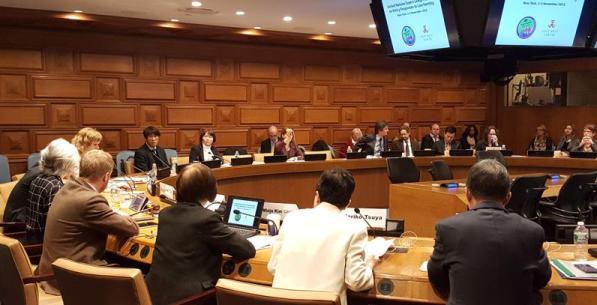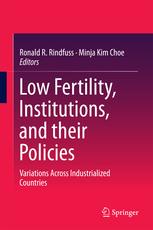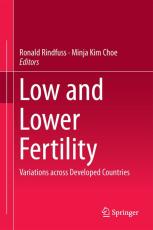Error message

THIS PROJECT IS NOT CURRENTLY ACTIVE.
Falling fertility and rising life expectancy are changing the age structure of populations all over the world. Many economically advanced countries, faced with persistent low levels of fertility, are experiencing declining proportions of children and working-age adults and growing proportions of older persons. These age-structure changes have profound implications for a broad range of policies and programs related to labor markets, social security, and healthcare systems. Two distinct low-fertility scenarios have emerged in economically advanced countries since the turn of the 20th century: one in which fertility is at or near replacement level and the other in which fertility is well below replacement.


Early in 2013, the Korea Institute for Health and Social Affairs (KIHASA) and the East-West Center agreed to collaborate on a project to improve understanding of the patterns and causes of fertility decline in various social, economic, cultural, and political settings and to consider the associated policy implications. The project identified low-fertility countries with varying fertility levels and trends, cultural backgrounds, social patterns, and economic conditions. For each country selected, an expert scholar was invited to write a country paper and to participate in a series of workshops for discussions with experts from other countries.
Results of this study were published by Springer International in two volumes. The first, released in 2015, presents an overview of the demographic and policy implications of the two low-fertility scenarios. Next, it explores five countries currently experiencing very low fertility rates: China, Hong Kong, Japan, Singapore, and the Republic of Korea. It then examines three countries that have close to replacement-level fertility: Australia, the Netherlands, and the United States. Each country is featured in a separate chapter written by a demographer with expert knowledge in the area. The second volume, published in 2016, included chapters on Austria and the Czech Republic, Canada, France, Hungary, Italy, Norway, Spain, Taiwan Province of China, and the United Kingdom plus two chapters that provide summaries and cross-country comparisons. These two books go beyond the technical to examine the core institutional, policy, and cultural factors that shape fertility levels and patterns.
Also based on this collaborative research project, the East-West Center and the United Nations Population Division held an Expert Group Meeting on Policy Responses to Low Fertility on 2-3 November 2015 at the United Nations Headquarters in New York. The purpose of the expert group meeting was to broaden the discussion by involving a larger group of policymakers, academics, and representatives of selected UN agencies and international organizations. The meeting distilled lessons learned and provided policy guidance for countries that are experiencing low fertility and population aging, and for those that are likely to face these challenges in the not too distant future. The discussion focused on identifying common features across selected countries and areas as well as distinctive cultural, institutional, and policy features that might affect fertility levels, either deliberately or inadvertently. Such features may include flexibility of the labor market, the link between marriage and childbearing, factors that help or hinder parents in balancing work and family obligations, gender equity, education systems, the housing market, and governmental subsidies for the cost of childrearing, among others.
More information on the expert group meeting is available at http://www.un.org/en/development/desa/population/events/expert-group/24/index.shtml. In conjunction with this expert meeting, the East-West Center and the United Nations Population Division published a series of 19 United Nations policy briefs on low fertility and related institutions and policies in countries around the world.

THIS PROJECT IS NOT CURRENTLY ACTIVE.
Falling fertility and rising life expectancy are changing the age structure of populations all over the world. Many economically advanced countries, faced with persistent low levels of fertility, are experiencing declining proportions of children and working-age adults and growing proportions of older persons. These age-structure changes have profound implications for a broad range of policies and programs related to labor markets, social security, and healthcare systems. Two distinct low-fertility scenarios have emerged in economically advanced countries since the turn of the 20th century: one in which fertility is at or near replacement level and the other in which fertility is well below replacement.


Early in 2013, the Korea Institute for Health and Social Affairs (KIHASA) and the East-West Center agreed to collaborate on a project to improve understanding of the patterns and causes of fertility decline in various social, economic, cultural, and political settings and to consider the associated policy implications. The project identified low-fertility countries with varying fertility levels and trends, cultural backgrounds, social patterns, and economic conditions. For each country selected, an expert scholar was invited to write a country paper and to participate in a series of workshops for discussions with experts from other countries.
Results of this study were published by Springer International in two volumes. The first, released in 2015, presents an overview of the demographic and policy implications of the two low-fertility scenarios. Next, it explores five countries currently experiencing very low fertility rates: China, Hong Kong, Japan, Singapore, and the Republic of Korea. It then examines three countries that have close to replacement-level fertility: Australia, the Netherlands, and the United States. Each country is featured in a separate chapter written by a demographer with expert knowledge in the area. The second volume, published in 2016, included chapters on Austria and the Czech Republic, Canada, France, Hungary, Italy, Norway, Spain, Taiwan Province of China, and the United Kingdom plus two chapters that provide summaries and cross-country comparisons. These two books go beyond the technical to examine the core institutional, policy, and cultural factors that shape fertility levels and patterns.
Also based on this collaborative research project, the East-West Center and the United Nations Population Division held an Expert Group Meeting on Policy Responses to Low Fertility on 2-3 November 2015 at the United Nations Headquarters in New York. The purpose of the expert group meeting was to broaden the discussion by involving a larger group of policymakers, academics, and representatives of selected UN agencies and international organizations. The meeting distilled lessons learned and provided policy guidance for countries that are experiencing low fertility and population aging, and for those that are likely to face these challenges in the not too distant future. The discussion focused on identifying common features across selected countries and areas as well as distinctive cultural, institutional, and policy features that might affect fertility levels, either deliberately or inadvertently. Such features may include flexibility of the labor market, the link between marriage and childbearing, factors that help or hinder parents in balancing work and family obligations, gender equity, education systems, the housing market, and governmental subsidies for the cost of childrearing, among others.
More information on the expert group meeting is available at http://www.un.org/en/development/desa/population/events/expert-group/24/index.shtml. In conjunction with this expert meeting, the East-West Center and the United Nations Population Division published a series of 19 United Nations policy briefs on low fertility and related institutions and policies in countries around the world.

